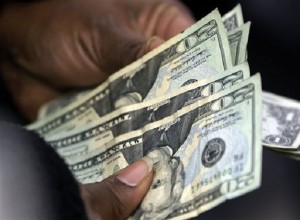
In this Monday, Feb. 25, 2013 photo, a customer counts her change after a purchase at Lodge’s store in Albany N.Y. U.S. consumers earned more and spent more in February, helped by a stronger job market that offset some of the drag from higher taxes, according to the Commerce Department, Friday, March 29, 2013. AP
WASHINGTON — U.S. consumers earned more and spent more in February, helped by a stronger job market that has offset some of the drag from higher taxes.
The Commerce Department said Friday that consumer spending rose 0.7 percent in February from January. It was the biggest gain in five months and followed a 0.4 percent rise in January, which was double the initial estimate.
Americans were able to spend more because their income rose 1.1 percent last month. That followed January’s 3.7 percent plunge and December’s 2.6 percent surge. The huge swings reflected a rush to pay bonuses and dividends in December before taxes increased. After-tax income increased 1.1 percent last month.
The jump in income allowed consumers to put a little more away in February. The saving rate increased to 2.6 percent of after-tax income, up from 2.2 percent in January.
Consumers spent more at the start of the year even after paying higher Social Security taxes. The increase, which took effect in January, has reduced take-home pay this year for nearly all Americans receiving a paycheck. Income taxes also rose on the highest earners.
The jump in spending and income suggest economic growth strengthened at the start of the year after nearly stalling at the end of last year. Consumer spending accounts for 70 percent of economic activity.
Most economists predict the economy is growing at an annual rate of roughly 2.5 percent in the January-March quarter. That would be a vast improvement from the 0.4 percent growth rate in the October-December quarter, which was held back by slower company stockpiling and the sharpest defense cuts in 40 years.
Inflation, as measured by a gauge tied to consumer spending, increased 1.3 percent in February compared with a year ago. That’s well below the Federal Reserve’s 2 percent target, giving the central bank room to keep stimulating the economy without having to worry about price pressures.
One reason the tax increases haven’t slowed the economy is companies have accelerated hiring and are slowly but steadily increasing wages.
Employers have added an average of 200,000 jobs a month since November. That helped lowered the unemployment rate to a four-year low of 7.7 percent in February. Economists expect similar strong job gains in March.
Most other signs point to an economy that is gaining momentum. Businesses are investing more in equipment and machinery, which has given factories a lift after a disappointing 2012.
And the housing recovery appears to be strengthening. In February, sales of previously occupied homes rose to the highest level in more than three years. The gains have helped lift home prices, which have made Americans feel wealthier.
Stock prices have also surged. On Thursday, the Standard & Poor’s 500 index closed at a record high of 1,569. That surpassed the previous record of 1,565 set in October 2007, a year before the peak of the financial crisis.
Markets will be closed when the consumer spending and income report is released on Good Friday.